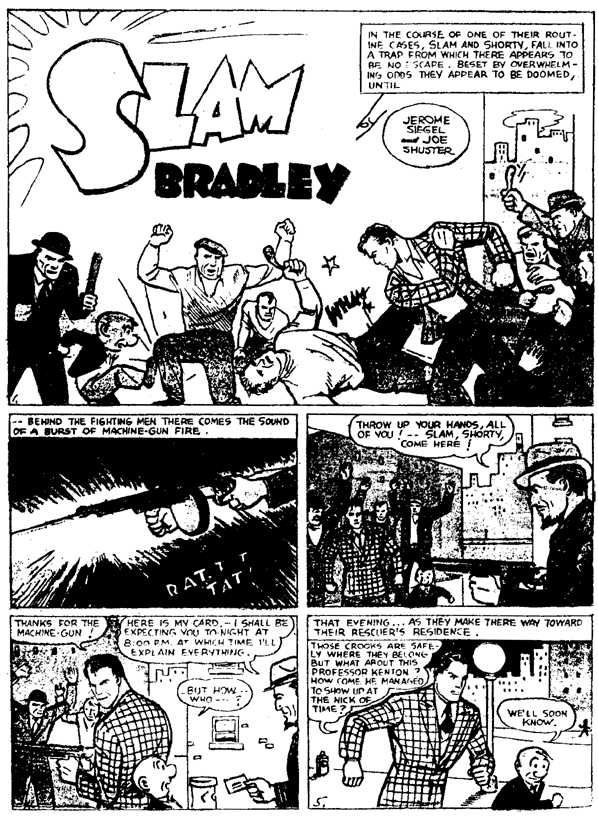Joe Shuster: Jerry picked up the technique of visualizing the story as a movie scenario; and whenever he gave me a script, I would see it as a screenplay. That was the technique that Jerry used, and I just picked it up.
Had you had a chance to see professionally written screenplays?
Jerry Siegel: Not at all. As a matter of fact, when we broke into the field, we both indulged in what we thought was very experimental stuff. In the writing, I tried to incorporate what was so popular in the pulp field into the comics field. I used a great number of captions along with dialogue balloons, visualizing the way a pulp comic should be. I feel now that we were pioneering, and that much of the stuff that followed was influenced by the way we handled our very early work, like Slam Bradley, especially.
Slam Bradley was a dry run for Superman. Superman had already been created, and we didn't want to give away the Superman idea; but we just couldn't resist putting into Slam Bradley some of the slambang stuff which we knew would be in Superman if and when we got Superman launched.

Where did Slam Bradley come from?
Joe Shuster: Oh, that's a very important part of our lives, a very important part of our background. Jerry often says that Slam Bradley was really the forerunner of Superman, because we turned it out with no restrictions, complete freedom to do what we wanted; the only problem was that we had a deadline. We had to work very fast, so Jerry suggested that we save time by putting less than six panels to a page: four panels or three panels, and sometimes two panels. I think one day we just had one panel to a page. The kids loved it because it was spectacular: I could do so much more. Later on, the editors stopped us from doing that; they said the kids were not getting their money's worth.
The actual character of Slam Bradley was Jerry's idea. They wanted an action strip, and Jerry came up with the idea of a man of action with a sense of humor. The character had a devil-may-care attitude very much like that of Fairbanks Senior's Zorro. Still, he couldn't fly, and he didn't have a costume.
When you first conceived Superman, did you have the dual-identity theme in mind?
Jerry Siegel: That occurred to me in late 1934, when I decided that I'd like to do Superman as a newspaper strip. I approached Joe about it, and he was enthusiastic about the possibility. I was up late one night and more and more ideas kept coming to me, and I kept writing out several weeks of syndicate scripts for the proposed newspaper strip. When morning came, I had written several weeks of material, and I dashed over to Joe's place and showed it to him. (This was the story that eventually appeared in Action Comics #1, June, 1938, the first published appearance of Superman.)
Joe Shuster: That was one very important day in our lives. We just sat down, and I worked straight through. I think I had brought in some sandwiches to eat, and we worked all day long.
Jerry Siegel: Of course, Joe had worked on that earlier version of Superman, and when I came to him with this new version of it, he was immediately sold. And when I saw the drawings that were emerging from his pencil I almost flipped. I knew he had matured a great deal since he had done The Superman, and I thought he was doing a great job on the new art.
Joe Shuster: I was caught up in Jerry's enthusiasm, and I started drawing as fast as I could use my pencil. My imagination just picked the concept right up from Jerry.

Jerry Siegel: You see, Clark Kent grew not only out of my private life, but also out of Joe's. As a high school student, I thought that some day I might become a reporter, and I had crushes on several attractive girls who either didn't know I existed or didn't care I existed. As a matter of fact, some of them looked like they hoped I didn't exist. It occurred to me: What if I was real terrific? What if I had something special going for me, like jumping over buildings or throwing cars around or something like that? Then maybe they would notice me. That night when all the thoughts were coming to me, the concept came to me that Superman could have a dual identity, and that in one of his identities he could be meek and mild, as I was, and wear glasses, the way I do. The heroine, who I figured would be a girl reporter, would think he was some sort of a worm; yet she would be crazy about this Superman character who could do all sorts of fabulous things. In fact, she was real wild about him, and a big inside joke was that the fellow she was crazy about was also the fellow whom she loathed. By coincidence, Joe was a carbon copy (of me).
Joe Shuster: I was mild-mannered, wore glasses, was very shy with women.
Jerry Siegel: So in the artwork, he was able to translate it; and he wasn't just drawing it, he was feeling it.
